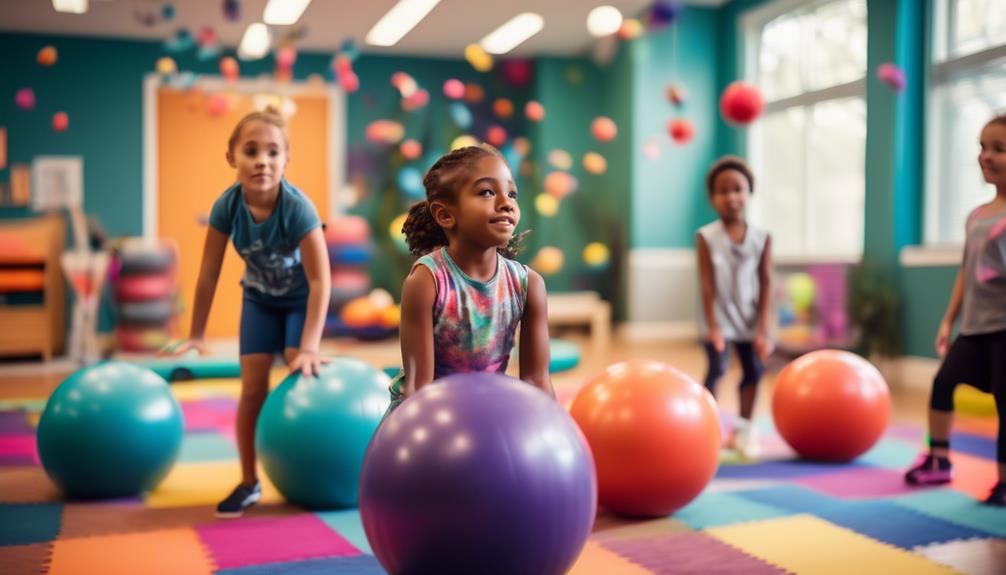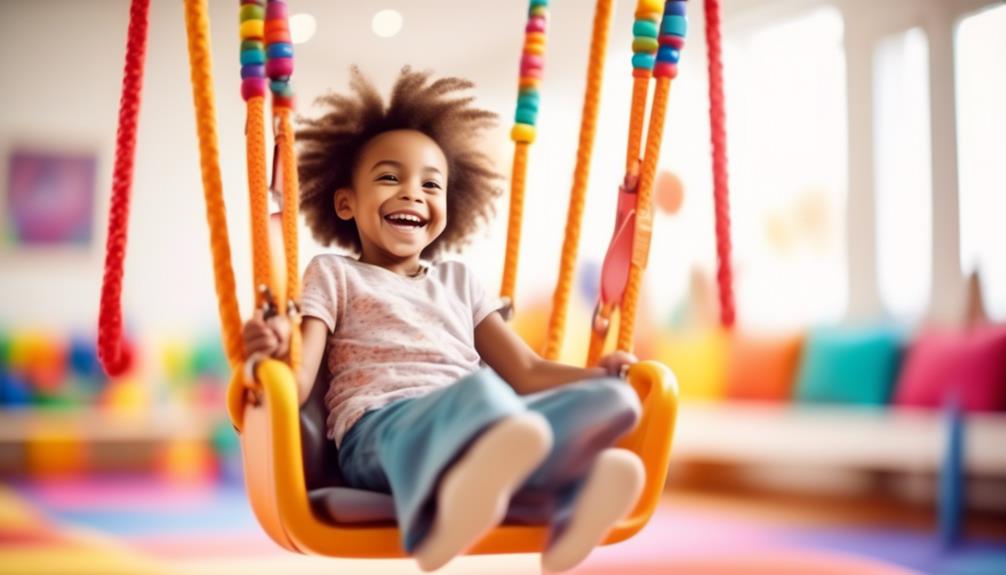Imagine your child’s mind as a symphony, each sensory input harmonizing to create a seamless experience of the world around them. However, this symphony can sometimes feel out of tune for children with sensory processing difficulties. As you strive to support your child’s individual needs, it’s crucial to comprehend the significance of sensory activities for kids in their development. These carefully designed exercises can help fine-tune their senses, improving coordination, sensory integration, and skill development.
You’ll find activities tailored to cater to each sensory system, from crafting a calming sensory bin to guiding them through proprioceptive muscle exercises. While the entire repertoire of 12 activities offers a comprehensive approach, let’s start by exploring how each can resonate with your child’s sensory challenges and pave the way for harmonious development.
Key Takeaways
- Tactile sensory activities, such as sensory bins and therapeutic brushing techniques, can help stimulate and regulate the tactile senses in children.
- Auditory sensory activities, such as auditory matching activities, can benefit children with sensory processing issues.
- Vestibular sensory activities, like swinging, can improve children’s balance and coordination.
- Fine motor sensory activities, such as crafting and playdough sculpting, can enhance fine motor skills and provide sensory input for children.
Tactile Sensory Bins
To foster sensory development and enhance tactile awareness, consider creating a tactile sensory bin using various materials like rice, beans, or sand for your child to explore. Tactile sensory bins provide a rich environment where children can delve into numerous textures, discovering how different substances feel against their skin. These bins are valuable for those seeking tactile experiences or grappling with sensory processing issues. They allow children to engage at their own pace, promoting a sense of control and comfort with touch.
To construct an adequate tactile sensory bin, choose a deep container and fill it with safe, non-toxic items. Include a mix of soft cotton balls, smooth buttons, and natural elements like shells to introduce a range of sensations. Remember to tailor the contents to your child’s needs, avoiding items that may cause overstimulation or anxiety.
As you guide children through this sensory exploration, remain observant and supportive. Please encourage them to describe their feelings, which can reinforce their learning and help you better understand their tactile preferences. By providing this calming and controlled sensory experience, you’re nurturing their curiosity and laying the groundwork for their continued sensory and cognitive development.
Therapeutic Brushing Techniques
While tactile sensory bins stimulate the sense of touch through exploration, therapeutic brushing techniques offer a more structured approach to sensory regulation, using targeted pressure to calm and focus the nervous system. For children with sensory processing disorder, these techniques can be a lifeline, helping them better integrate proprioceptive input and navigate their environment with less distress.
Consulting with a pediatric occupational therapist is essential when considering therapeutic brushing techniques. They’ll guide you in applying the specific type of brush and following the Wilbarger Protocol—a proven pattern that helps to desensitize the nervous system. Here’s how you can emotionally connect with the impact of these techniques:
- Imagine the relief a child feels as overwhelming sensations are tamed, creating a moment of peace.
- Envision the joy parents experience seeing their child more engaged and less anxious.
- Feel the pride in providing a tool that empowers children to handle sensory challenges better.
Proprioceptive Muscle Exercises

Children can gain greater body awareness and control by engaging in proprioceptive muscle exercises essential for their sensory and emotional development. These activities, often called heavy work, provide vital sensory input that helps regulate the body’s response to the environment. Kids strengthen their muscles by pushing, pulling, lifting, and carrying heavy objects, enhancing their sensory information processing ability.
Incorporate activities like climbing, jumping, and playing on soft surfaces to offer additional proprioceptive input. These exercises are not just about building muscle tone; they also support the vestibular system, contributing to balance and spatial orientation. When children engage in such activities, they learn to precisely negotiate their movements, an essential skill for everyday tasks.
Balance Beam Challenges
Navigating a balance beam challenges children to fine-tune their coordination and body awareness, offering a playful yet structured way to enhance their sensory processing skills. When you introduce a balance beam into sensory Therapy, you’re not just helping kids walk a straight line; you’re inviting them to engage with sensory challenges that stimulate their vestibular system, improve focus, and build confidence.
To evoke emotion and create a deeper connection to these activities, consider the following:
- Imagine the pride a child feels when they conquers the wobbly uncertainty of a textured balance beam.
- Picture the joy that bubbles up when a balance beam turns into a game, complete with cheers and celebration.
- Visualize the determination in each focused step as a child navigates an obstacle course, integrating balance and spatial awareness like a tiny acrobat.
Use different textures on the beam, such as foam or sand, to provide varied tactile feedback. Encourage visual tracking by having children follow patterns or lines. Most importantly, keep it fun by gamifying the experience. Your role guides them through these growth-filled moments, fostering an environment where every challenge on the balance beam is a step towards greater sensory integration.
Deep Pressure Therapy

Moving on to deep pressure therapy, you’ll find it’s a powerful tool to help children struggling with sensory overload. By applying methods such as using weighted blankets or giving gentle squeezes, you can provide a sense of security and calm. These techniques not only soothe but also assist in regulating emotions and behaviors, offering tangible benefits for kids needing sensory regulation.
Benefits of Deep Pressure
Through the application of deep pressure therapy, children with sensory processing difficulties can experience a significant reduction in anxiety and an increase in emotional and behavioral regulation. This form of Therapy, which includes heavy work and is a critical component of sensory integration strategies, often utilizes tools such as weighted blankets, lap pads, and compression clothing.
- Soothing Comfort: Deep pressure can mimic a comforting embrace, providing a haven from overwhelming sensations.
- Enhanced Focus: By reducing anxiety, children are often better able to concentrate and engage in learning activities.
- Improved Body Awareness: Regularly integrating deep-pressure activities can help children discern the position and movement of their bodies, enhancing coordination and confidence.
Implementing Pressure Techniques
To effectively implement deep pressure therapy techniques, it’s essential to apply firm, consistent pressure in a way that feels secure and comforting to the child. This type of sensory input, known as heavy work, can be especially beneficial for muscles and joints, thereby regulating the sensory system.
| Activity | Purpose | Implementation |
|---|---|---|
| Weighted Blankets | Provides calming pressure | Use during rest or quiet time |
| Compression Garments | Enhances body awareness and muscle tone | Wear throughout the day |
| Stress Balls | Focuses attention and reduces fidgeting | Squeeze rhythmically |
Incorporating these activities into daily routines can significantly ease the sensory overload for children with processing difficulties. It’s about understanding their needs and providing a comforting, therapeutic touch.
Auditory Sound Matching
Let’s explore how auditory sound matching activities, such as ‘sound bingo’ or ‘sound memory match,’ can enhance your child’s ability to discern and pair similar sounds, supporting their auditory processing and language development. These activities offer a fun and engaging way to help children sensitive to sensory stimulation, including loud noises, or need to sharpen their listening skills.
- Joyful Engagement: Watch your child’s face light up with recognition as they make correct matches, turning learning into a delightful game.
- Quiet Confidence: Observe their pride when mastering new sounds, fostering a sense of accomplishment and self-esteem.
- Shared Connection: Experience a special bond as you cheer them on, knowing you’re directly contributing to their developmental success.
Vestibular Swinging Activities

Swing into action with vestibular swinging activities designed to enhance your child’s balance and coordination while offering a fun approach to sensory integration therapy. These activities stimulate the vestibular system, crucial for sensory processing, by incorporating movements such as swinging back and forth, spinning, and rocking.
When you engage children in vestibular swinging activities, you’re not just playing—you provide them with vital sensory experiences that can improve their spatial orientation and motion awareness. For some children, these movements can have a calming effect, while for others, they can be energizing. This versatility makes vestibular swinging activities valuable in regulating sensory processing for diverse needs.
As you guide children through these activities, you must be attentive to their responses, adjusting the intensity and type of movement to suit their sensitivities. Whether gently rocking a child or encouraging them to swing more dynamically, your goal is to provide a safe and supportive environment where their sense of balance and body coordination can flourish.
Fine Motor Crafting
While vestibular swinging activities focus on balance and coordination, fine motor crafting shifts our attention to the intricate development of small muscle movements in the hands and fingers. As you guide children through the creative world of fine motor crafting, you’re not just facilitating fun—you’re bolstering their ability to perform everyday tasks with ease and confidence. Occupational Therapy often integrates these activities to enhance Sensory Processing and the development of fine motor skills.
Crafting can involve:
- I cut and paste shapes to create a mosaic, sharpening hand-eye coordination and control.
- Threading beads onto a string promotes talent and the all-important pincer grasp.
- I draw intricate patterns or shapes to aid in precision and grip strength.
Scent Exploration Games

Delving into scent exploration games, you’ll find a unique opportunity to enhance a child’s sensory development and cognitive skills through the power of smell. These sensory processing activities for kids are enjoyable and crucial in helping them respond to sensory stimuli effectively. By engaging in these olfactory challenges, children can refine their ability to identify and recall different scents, a vital part of their Sensory Diet.
To get started, you can create DIY scent jars with various fragrances for children to guess. Alternatively, organize a nature-themed scavenger hunt where little ones must identify scents found outdoors. Themed scent memory games are also fantastic, where kids match scents to corresponding pictures or objects. Here’s a simple table to guide you:
| Activity Type | Description |
|---|---|
| Scent Jars | Fill jars with various scents and have children guess them while blindfolded. |
| Scavenger Hunt | Create a list of scents to find in nature or around the house. |
| Memory Game | Pair scents with pictures or objects and have kids match them. |
Visual Tracking Mazes
Building on the sensory journey, let’s explore visual tracking mazes, an activity designed to sharpen a child’s visual perception and coordination skills. These specially crafted mazes are more than just a game; they’re a developmental tool that strengthens the eyes’ ability to follow moving objects and improves visual scanning techniques, which are crucial for reading and writing. As children navigate their way through the intricate paths, they’re not only having fun but are also boosting their visual processing speed and attention.
Incorporating visual tracking mazes into sensory processing therapy offers a delightful challenge that can be adjusted to match each child’s unique needs. Here’s what you can expect:
- Joyful Triumphs: Celebrate each victory as children overcome maze obstacles, enhancing their confidence and motivation.
- Engaged Focus: Watch as kids become absorbed in the activity, developing visual and cognitive skills with intense concentration.
- Moments of Connection: Join in the fun, guide when needed, and witness the growth in their abilities, fostering a bond through shared success.
Oral Motor Chewables

Transitioning from visual activities, consider oral motor chewable as a practical tool to satisfy your child’s need for oral stimulation and enhance their mouth muscle coordination. These chewables are designed to provide the sensory information that some children actively seek, helping improve oral motor skills and mitigate sensory-seeking behaviors.
Oral motor chewables come in various textures and strengths, allowing you to tailor the experience to your child’s sensory requirements. It’s essential to supervise your child while they use these chewables. This precaution ensures they safely explore their sensory needs without any choking hazards.
Occupational Therapists often recommend these tools as part of a comprehensive therapy plan. They can be incredibly beneficial, particularly for children with difficulties processing sensory information or those who demonstrate an increased need for oral sensory input. Incorporating chewables into your child’s sensory diet addresses their oral sensory challenges and contributes to their overall sensory integration.
Remember to consult with a professional when selecting oral motor chewables. Their expertise will guide you in choosing the most appropriate type and texture for your child, ensuring a safe and effective therapeutic experience.
Interactive Playdough Sculpting
As you introduce your child to interactive playdough sculpting, you’re not just fostering their creativity but also enhancing their tactile sensory input. This hands-on activity offers numerous benefits, from boosting fine motor skills to improving hand-eye coordination. Encourage your little ones to express their imagination through playdough manipulation, making it a delightful addition to their daily sensory play.
Benefits of Playdough Manipulation
When children engage in interactive playdough sculpting, they create with their hands, enhancing their fine motor skills and hand-eye coordination. This sensory processing activity is pivotal for children with sensory processing challenges. As they mold and shape, they create a sensory-rich experience that is both calming and educational.
- *Feel the joy as a child’s face lights up, mastering a new shape and building confidence through tactile exploration.*
- *Experience the pride in helping children regulate their emotions as they squeeze and roll the dough, finding peace in the simple movements.*
- *Witness the growth in spatial awareness and visual skills, as little hands turn a formless blob into a work of art.*
Enhancing Tactile Sensory Input
Building on the benefits of playdough manipulation, let’s explore how to enhance tactile sensory input through interactive playdough sculpting. This technique further develops a child’s sensory experience and fine motor skills. By encouraging children to knead, squeeze, and roll playdough, you’re offering them joyful sensory processing therapy activities for children and stimulating their tactile senses. Use various tools and objects to create imprints, patterns, and shapes, which promotes creativity and cognitive development.
In occupational Therapy, providing a variety of playdough colors and scents can further enrich the sensory experience. Such diversity in sensory input can be particularly beneficial for children with sensory processing challenges. Your empathetic guidance during these activities will foster a supportive environment for growth and learning.
Encouraging Creative Expression
Please encourage your child’s creative expression by introducing interactive playdough sculpting, where they can manipulate and shape the dough using various tools and materials. This approach fosters imagination and serves as a valuable sensory processing therapy activity for children. Offer open-ended prompts to inspire their creations, and engage alongside them to strengthen your bond.
- *Delight in your child’s joy* as they bring their imaginative stories to life with playdough.
- *Feel the pride swell* within you as your child with sensory processing challenges overcomes obstacles through creative play.
- *Cherish the moments* of connection as you both lose yourselves in the art of sculpting.
Frequently Asked Questions
What Kind of Therapy Activities Can a Child With Sensory Processing Disorder Take Part to Improve a Variety of Developmental Features?
You can engage your child in tactile play with sensory bins and homemade playdough to enhance their motor skills, language, and visual perception, all crucial for developmental progress.
What Are Sensory Activities Examples?
Dive into a world of tactile treasures with sensory bins filled with beans, or mold your emotions with homemade playdough. Balance and coordination blossom through log roll yoga, nurturing a calm, focused mind.
What Are Examples of Sensory Activities for Kids?
You can engage in activities like creating sensory bins, making homemade playdough, practicing log roll yoga, and playing with weighted hot potatoes to help children effectively develop their sensory processing skills.
How Do You Teach a Child With Sensory Processing Disorder?
To teach a child with a sensory processing disorder, patiently introduce structured activities that gradually increase their tolerance to different sensations, always respecting their comfort level and encouraging them through each new challenge.
Conclusion: communication skills? Look no further!
One simple activity is to fill a plastic tub with water and add bath toys, rubber bands, or even drops of food coloring for a tactile experience. If you want to get more creative, try making rainbow rice by mixing food coloring with rice or using cotton balls, water beads, or bubble wrap.
Playing with balls, monkey bars, or exercise balls can provide sensory stimulation while improving coordination and motor skills. For a fun beach sensory experience, bring along a bucket of water and some bright lights, or try a beach ball or bubbles.
Sensory play ideas can be from household items like food, cotton wool, or water. These activities for kids can also help develop social and communication skills.
School Time Snippets and Busy Toddler are great resources for activity ideas that are both fun and educational. And don’t forget about charitable activities, such as donating to food banks or participating in Toddler Playtime.
Remember, limiting screen time and encouraging children to engage in activities that promote healthy development, such as tummy time and exercise, is essential. With these fun learning experiences, your toddler will stay busy while improving their cognitive, social-emotional, and writing skills.


Recent Comments